“Monet is just an eye, but God, what an eye.” Paul Cézzane on Claude Monet
If you forced me to choose an all-time favorite artist, I would have to go with Claude Monet. Discovering his work led me down an endless rabbit hole of color, light, and the challenge of capturing life’s fleeting effects on canvas. This post is a distillation of his life and work. I’ll cover:
- Key Facts, Events, and Ideas
- Color and Light
- Brushwork, Technique, and Process
- Style Progression
- Friends With Masters
- Portraits and Photos
- Personal Favorites
- Key Takeaways
- Want to Learn More?
- Thanks for Reading!

Key Facts, Events, and Ideas
I’ll briefly run through some of the key facts, events, and ideas from Monet’s life:
- Monet started drawing at an early age and gained recognition for his caricatures of teachers and community members. These cheeky caricatures started it all. They gave Monet the positive reinforcement needed to fan the flames of a child’s interest; they were an avenue for practice; and they led to him meeting Eùgene Boudin, who would go on to play a pivotal role in Monet’s life (discussed more in the next point). In his own words:
“At fifteen I was known all over Le Havre as a caricaturist. My reputation was so well established that from all sides people came to me and pestered me for caricatures. I had so many requests, and the pocket money my mother could spare me was so meager, that I was led to take a bold step, one which needless to say shocked my parents: I started selling my portraits. Sizing up my customer, I charged ten or twenty francs a caricature, and it worked like a charm. Within a month my clientele had doubled. Had I gone on like that I’d be a millionaire today.”

- At 17, Monet met Boudin. Boudin saw promise in Monet’s caricatures and introduced him to the world of plein air painting (painting outdoors).
“Boudin came over at once and started talking to me in his soft voice, saying nice things about my work: ‘I like your sketches, they’re very amusing, very neatly done. You’re gifted, anybody can see that. But you’re not going to stop there, I hope. This is all right for a start, but you’ll soon have had your fill of caricature. You want to buckle down and study hard, learn to see and paint, go out and sketch, do some landscapes. What beauty there is in the sea and sky, in animals, people and trees, just as nature made them, just as they are, with a character of their own, with a life of their own in the light and air of nature.'”
- In 1859, Monet moved to Paris and attended the Académie Suisse. There he met Camille Pissarro, who would end up being a lifelong friend and fellow pioneer of Impressionism.
- Monet’s early career was challenging, as is the case for most artists. He had a few successes but struggled financially. He was supported mostly by his wealthy aunt, Marie-Jeanne Lecadre, but it was never enough to make him feel comfortable as an artist.
- In 1865, Monet met an art model by the name of Camille Concieux. She would go on to become Monet’s first wife and mother of their two children. Sadly, her life was short and tragic. Monet struggled to support her and their children and she passed away from illness at just 32, before benefiting from Monet’s eventual success. This article on The Guardian provides some interesting details on her life and relationship with Monet. She is featured in many of Monet’s paintings, including The Woman in the Green Dress (below). This painting was one of Monet’s first commercial successes, exhibiting at the 1866 Paris Salon and selling for 800 Francs.

- In 1869, Monet traveled with Pierre-Auguste Renoir to the outskirts of Paris and the spa resort of Grenouillèr. They sat side-by-side and painted major works of the same name-La Grenouillèr. I always find it interesting when two artists paint the same subject. It demonstrates the power of perspective and how we all see the world differently. I actually prefer Renoir’s painting in this case, but Monet was only starting to find his feet. You can see Monet’s style evolving from his earlier and darker paintings into fresher and more lively works. But this was viewed unfavorably by the Salon judges.
Note: Throughout Monet’s career, there were several pivotal moments where he decided to take the less desirable road so that he could continue pursuing his dreams and ideas about painting. He probably would have been better off had he continued as a caricaturist or a ‘Salon’ painter. But had he done that, we might not be discussing his work today.
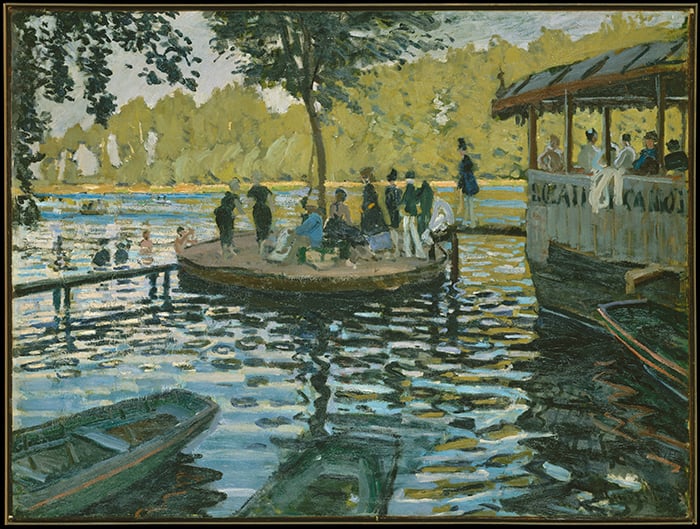

- In 1874, Monet and several like-minded artists exhibited at the Salon des Refusés (Exhibition of Rejects). This comprised of artworks rejected by the official Salon. Art critic, Louis Leroy, called it “impressionist” after Monet’s Impression, Sunrise. Little did he know, what was meant as an insult would become the name of the movement.

- A key practice in Monet’s study of color and light was painting the same subject over and over again in varying conditions. He did this with haystacks, water lilies, the Rouen Cathedral, and the Waterloo Bridge, just to name a few. Whilst I’m unsure if Monet was the first to do such a thing, he was certainly the first to practice it to such an extreme.

- Monet obsessed over his Giverny gardens in the second half of his career. They would become one of his greatest artworks, with exotic plants, poppies, roses, fruit trees, bridges, ponds, weeping willows, wisterias, and water lilies. All of which are featured throughout his later work. Monet’s success in his late-career allowed him to invest significantly in his gardens. He hired numerous gardeners, acquired rare and exotic plants from Egypt and America, and had a Japanese bridge built across the pond, inspired by the Japanese prints he collected (more details on his print collection here). This page has some excellent information on the gardens. You can also see Monet scrolling through his gardens in this video.
“I perhaps owe having become a painter to flowers.” Claude Monet

- In his final years, Monet battled failing eyesight due to cataracts. What a tragic thought-an artist like Monet gradually losing his eyesight. But he kept on painting. You can see the dramatic effects of his condition in paintings like The Japanese Footbridge. It always amazes me how powerful the simple act of painting can be. There is something about it that compels artists to endure incredible hardships in search of those rare glimmers of pure joy and excitement. Not even failing eyesight could stop Monet from painting.

Color and Light
“Color is my daylong obsession, joy, and torment.” Claude Monet
Color and light are the first things that come to mind when I think of Monet. He spent his life exploring their often subtle relationships. It was as if painting was merely a vehicle for him to do this.
Many of his works are nothing more than ambient displays of color, with little focus on drawing and rendering. He had no interest in being the next Rembrandt, rather, his primary aim was to capture nature’s light and color on the canvas. And he came pretty close too!
Monet’s understanding of color and light is even more impressive when you consider the environment in which he worked. Scientific understanding of color and light at the time was primitive compared to today. And Monet didn’t have a “Monet” or other Impressionists to study from. Sure, there were many great artists that came before him, but there were few true colorists.
As mentioned earlier, one of his key practices was painting the same subject over and over again. The constant subject allowed him to better observe the color relationships under varying conditions. Haystacks was his first major series, which he discussed in a letter to Gustave Geffroy in 1890:
“I’m hard at it, working stubbornly on a series of different effects, but at this time of year the sun sets so fast that it’s impossible to keep up with it … the further I get, the more I see that a lot of work has to be done in order to render what I’m looking for: ‘instantaneity’, the ‘envelope’ above all, the same light spread over everything… I’m increasingly obsessed by the need to render what I experience, and I’m praying that I’ll have a few more good years left to me because I think I may make some progress in that direction…”

A few years later in 1892, he rented an apartment in France and commenced work on his Rouen Cathedral series. A much more challenging subject, with many nooks and crannys, crevices, edges, shadows, patterns, and highlights. This allowed Monet to explore a wider and more complex range of color relationships.

His last and most recognized series is Water Lilies. An ambient display containing around 250 works. Artist, André Masson, sums it up well as the “Sistine Chapel of Impressionism”.
This series is a perfect example of an analogous color scheme (colors that are close on the color wheel). Monet wove together all kinds of greens, blues, and purples. The result is a harmonious display. Every now and then he might use a warm yellow, red, or orange accent for a flower to command your attention.
You can see them all on this Wikipedia list.

“I hate darkness. Claude Monet once said that painting in general did not have light enough in it. I agree with him. We painters, however, can never reproduce sunlight as it really is. I can only approach the truth of it.” Joaquín Sorolla
Monet often painted within a high key (light colors). Instead of dark black and brown shadows, he opted for more colorful options-blues, greens, purples, reds, greens. Notice the deep blue shadows in the Grand Canal for example.

Painting within a high key does come at the sacrifice of the full value range. Without black, you cannot get that sharp value contrast that you might see in a Rembrandt.
Broken color was one of Monet’s primary tools for capturing the effects of light. If you look closely at his work, you’ll see a patchwork of distinct colors. Take the painting below, Belle-Ile, Rocks at Port-Goulphar.

If we zoom in on the painting, we can see the water is made up of many tiny and distinct strokes of color. Blues, greens, purples, and grays. It looks abstract up close, but it all comes together as you step back.

As for Monet’s color palette, he said this in 1905:
“As for the colors I use, what’s so interesting about that? I don’t think one could paint better or more brightly with another palette. The point is to know how to use the colors, the choice of which is, when all’s said and done, a matter of habit. Anyway, I use flake white, cadmium yellow, vermilion, deep madder, cobalt blue, emerald green, and that’s all.” (Source)
He made a great point: An artist’s color palette is often nothing more than habit. Understanding how to use your colors is more important than the colors you have.
Brushwork, Technique, and Process
Monet typically used short, broken strokes. Similar to Vincent van Gogh, but less stylized.
The reasoning behind Monet’s brushwork might be that it was simply a fast way to paint, as was required when painting outdoors with the changing conditions. It also allowed him to take advantage of broken color. Instead of finely blending two colors together, Monet would weave together strokes of distinct and often rich color.
He used vague detail, doing just enough to suggest form, but leaving the rest up to our imaginations. Let’s go back to his Impression, Sunrise as an example. Monet and the other Impressionists were initially mocked for this brash, seemingly unfinished brushwork. Yet today Monet and the Impressionists are widely admired. That’s one of the harsh realities of painting (and most aspects of life)-those who pave the way are often met with the harshest resistance.

As for how Monet went about a painting, there is limited information on this. But my best guess is that he worked in a direct manner, building up a patchwork of tiny strokes until the subject emerges. He matched his brushwork to the nature of the subject and painted with emotion. For broad objects, he used broad brushwork. For intricate, active subjects, he used smaller brushes and energetic brushwork.
Many of his paintings appear to be a mix of wet on wet and wet on dry. This suggests he rapidly filled the canvas with color, then refined it later once the paint had dried. Wet on dry is particularly effective for capturing the glimmering effects of light by scumbling a light color over a dry, dark surface.
He often worked on several paintings at the same time, changing between them to match the conditions. In 1892 he vented to his second wife, Alice Hoschedé about his Rouen Cathedral series:
“Dear God, this cursed Cathedral is hard to do… Fourteen paintings on the go today…I’m exhausted and it seems that every day the light changes: it gets whiter and higher up.”
He did most of his work on location but continued to refine the paintings in his studio. This way he got the best of both worlds.

Style Progression
Monet had a long and prolific career, creating almost 2,000 paintings. This allows us to step back and observe how his style and skills evolved over time.
His early work is unlike what you would expect from Monet. Restrained colors, deep black and brown shadows, and intimate compositions. These were Monet’s academic years, before he truly discovered color.
Below is Monet’s earliest documented painting. A pleasant landscape with realistic colors and fine rendering. One of the key differences between this and his later work is the use of dark, black/green shadows. This creates a sharper value contrast (light against dark) at the expense of color.

He also painted several academic still lifes, like Still Life With Meat. It’s warm and dramatic. You can tell it’s an early work as it bears an unusual Monet signature-“M.” or “Mo”. Most of his other works are signed with his full name, plus on occasion the year.

A Jar of Peaches is another classic still life, but you can see hints of the relaxed brushwork that would later become a key feature of his work (see the highlights at the bottom of the painting).

Monet isn’t remembered for these early academic paintings, but they are important in that they set the foundation for the rest of his career. His fundamentals were strong enough that he could relax his brushwork and push the colors without completely compromising the sense of realism.
Over time, Monet’s paintings become more lively and colorful. The following two paintings of Étretat are a great demonstration of this evolution. This is Monet before and after color.


When you can get a chance, take a look through this full list of Monet’s documented paintings so you can see his style evolution for yourself. You will also notice that some paintings are much better in a technical sense than others. Not everything he touched was a masterpiece. This is not to diminish his talents, but rather to appreciate that he too had to struggle, experiment, practice work to create his masterpieces.
Friends With Masters
Monet brushed shoulders with many other master artists. Camille Pissarro, Mary Cassatt, Auguste Renoir, Alfred Sisley, Vincent van Gogh, Frederic Bazille, and so on. This perhaps is one of the reasons for his success. He was exposed to such a breadth of talent and experience. And not just from other Impressionists. He was friends with master realist John Singer Sargent. Their relationship was mutually beneficial: Monet with his knowledge of color and light, Sargent with his meticulous fundamentals. You can see Monet’s influence in Sargent’s painting below. It is unlike Sargent’s typical work, with relaxed brushwork and vague detail. An appropriate way to paint the Impressionist master.

Monet was painted a number of times by fellow artists (see below). This is a testament to his influence and standing in the art community at the time. Édouard Manet’s The Monet Family in Their Garden at Argenteuil is my favorite, with Monet taking a back seat role to his wife and child.
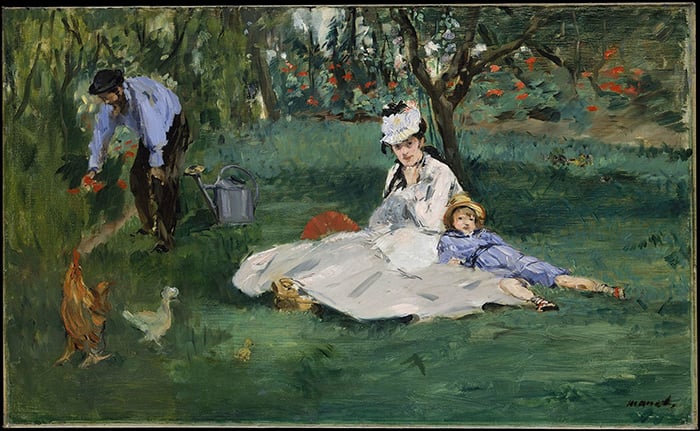

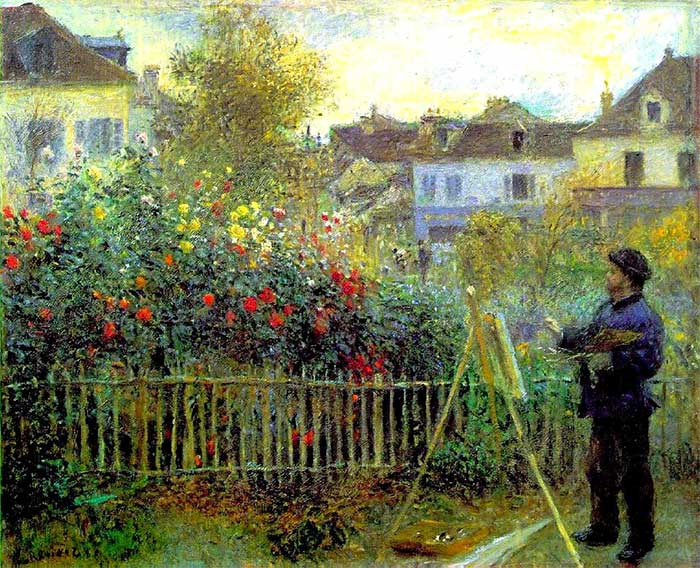



Note: The art life can be an isolated and troublesome road to take. Make sure you connect with others, like Monet did with the likes of Renoir, van Gogh, etc. Artists need to support each other.
Portraits and Photos
I could only find two self-portraits by Monet. The first is Monet in his 40s, the second in his 70s.


This painting was also attributed to Monet’s brush until recently. I stumbled across this article that suggests it is by Swiss artist, Charles Giron. This makes sense based on Giron’s other work-the style is very similar.

There are also several photos of Monet in his gardens. I always find it helpful to put a face to the artist. It helps us take them down from the pedestal and see them as they were-artists like us trying to make it on their own journey.



Personal Favorites
I’ll run through some other personal favorites, starting with Woman Seated Under the Willows. The woman melts into the surrounding landscape. Notice the use of simplification. Monet was able to get away with only the slightest hint of form. I also love the use of rich, green accents to add depth to the foreground.

Vétheuil: What stunning use of broken color to capture the shimmering water. It must be quite a sight in person.

Pear Tree in Flower: A simple and colorful display. Notice the rich blue and red accents for the shadows.

Jetty at Fecamp in Rough Weather: A great display of emotion and drama. Monet’s brushwork mimics the water’s movement and nature.

Jean-Pierre Hoschedé and Michel Monet on the Bank of the Epte: An interesting play between the trees and the water’s reflections. Also, notice how the reflections are slightly darker and richer.

Haystack: Perhaps my favorite from his haystack series. This is one of those paintings that gets more interesting and complex the closer you look. Monet was able to use such rich color without it appearing gnarish.
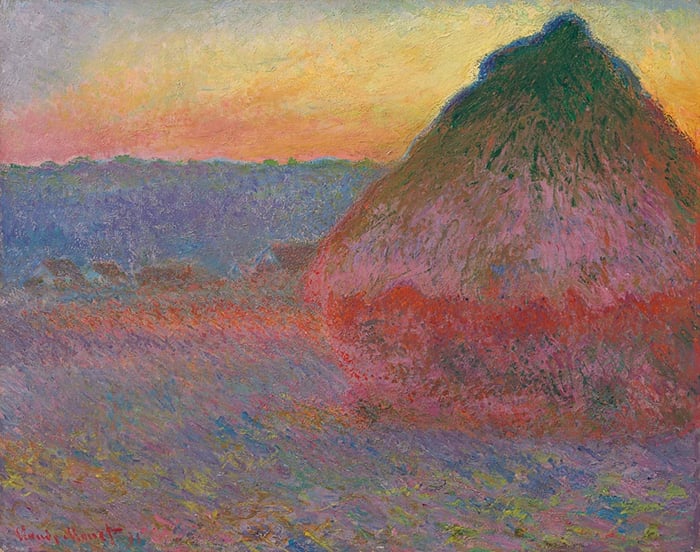
Foggy Morning at Pourville: A high-key (light) painting with small dark accents. This is an effective color combination that Monet often utilized. It works particularly well for sunny, glaring days.

Springtime: A beautiful demonstration of dappled light and how to paint white in shadow.

Key Takeaways
Here are some of the key takeaways from this post:
- There can be nothing more valuable than nurturing a child’s interest or talent, like Boudin did for Monet.
- The art life is rewarding yet challenging. Monet endured incredible hardships in the creation of his work.
- To truly experience color and light, paint outdoors amongst nature. A camera is helpful, but cannot replace our own sight and experience.
- Public opinion is fickle. Monet’s work was initially shunned, but today is revered. Paint for yourself first and foremost.
- Painting the same subject over and over again allows you to better explore the often subtle relationships between color and light.
- Painting with more color typically means sacrificing the full value range. Unfortunately, you cannot paint with both the drama of Rembrandt and the color of Monet.
- Broken color was Monet’s primary tool for capturing the effects of light.
- Monet’s style evolved over time as he explored different ways of capturing his ideas. Don’t be confined to the same way of painting.
- Monet brushed shoulders with many other master artists. His exposure to such a wealth of talent and experience would have played a key role in his own success.
- Looking at photos of master artists can help you take them down from the pedestal. They were artists too, with all the struggles that come with it.
Want to Learn More?
You might be interested in my Painting Academy course. I’ll walk you through the time-tested fundamentals of painting. It’s perfect for absolute beginner to intermediate painters.
Thanks for Reading!
I appreciate you taking the time to read this post and I hope you found it helpful. Feel free to share it with friends.
Happy painting!
Dan Scott

Draw Paint Academy

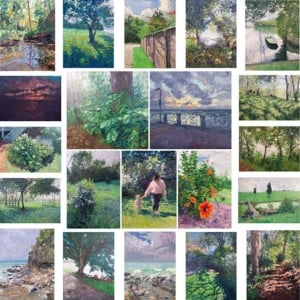
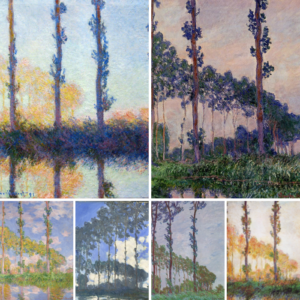
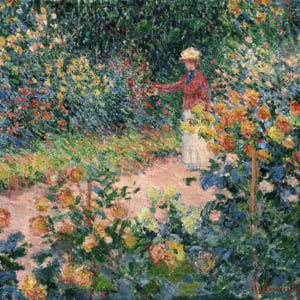
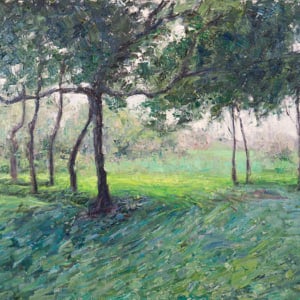
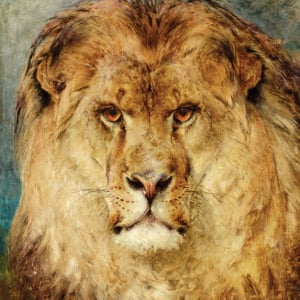
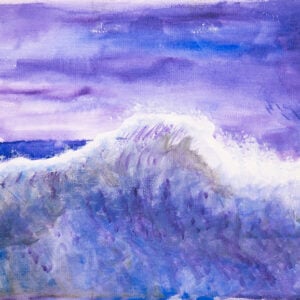
This deep dive into a great painter is exhilarating. Thank you so much. Any chance you could do the same for Matisse, my personal favorite?
Thank you very much for this email in my mailbox. I live in Holland we’re Monet made some paintings. We have, a view years ago, opens an Monet Atelier were people can see his paintings made in this area. I had the privilege to exhibit there a painting when the atelier opens. (Sorry for my English. It is not my language)
Because it was 150 years ago there is Next month a auction of paintings made related to Monet. Also we had a exhibition of paintings related of Monet. So everything with you’re mail comes together. There is also a walk that people can see we’re the paintings from Monet were made. So thank you!
I really enjoyed this and gained immeasurably from it. Your postings are so thorough and so interesting. Many thanks
Tom Sutcliffe
Newlands
Cape Town
Very interesting blog. I enjoyed your showing of Monet’s move from dark ‘real’ painting to impressionist.
Oh, Dan! Thank you so much. This completely brightened my mood. I have been dealing with my own eye problems and caring for my husband who has dementia. Your piece took me out of myself. I have always loved Monet’s work and even got to see a few originals. Beautiful.
Thank you so much for putting in the time to write this. A really great read!
I am so enjoying (and learning) from your articles. They’re succinct and point on. Thank you.
Thank you for posting this, I will save and refer to it often.
Did you ever see the PBS special called The Impressionists? It is SO wonderful!! I recall it being about 3 hours long but I’ve watched at least 3-4 times and can be seen on YouTube – inspiring, informative and romantic!
I really enjoyed this article on Monet I have
always loved his work found this most informative thank you
Thank you so much for this very inspiring article. I just started a seascape yesterday on a large canvas, my biggest so far and reading through this study has really helped me envision what I want to achieve.
For those of you that are able, do go and see the Van Gogh Live exhibition. To see the canvases blown up onto huge screens really allows one to study the colours and brush strokes which make up his wonderful works. The unexpected use of colours is quite amazing.
Thank you again.
Excellent Exhibition of Claude Monet Paintings.
What an excellent piece. Enjoyed every bit of it…….nice work!
EXCELLENT ANALYSIS AND PRESENTATION
THANK YOU
Great article! A contribution to the cultures of its readers. My humble appreciation for a new great job, Dan.
I so appreciated this. All the links took me down the rabbit hole and I loved every minute never wondering what time it may be. Thank you for your perspective as it has proved so helpful in breaking down the pieces of the art and the artist. I had no idea Monet did caricatures!
Thank you for this enlightening document! It is so thorough and well-done, as all your materials are. I learn so much when I read what you have written.
Thanks again!
I always enjoy your studies but you really outdid yourself on this one. Thanks for being such a wonderful source of information and education about artists and their works.
Thank you such a thoughtful portrait of Monet. I especially benefited from the presentation of his process of painting the same subject in a series, seeing them together in one place.
Thank you so very much for taking the time to write and post this wonderful story. I am so glad I found your website, it’s truly inspiring.
Boynton Beach, Fl
This information was so very interesting and informative. All your work is greatly appreciated. Loved all
the background information. New to me in many ways.
Thank you immensely, Charlotte H.
Excellent read! Thank you so much for all your research.
muy buen articulo,quede bastante motivado a seguir pintando no como monet sino a mi manera gracias
Dan, my own mentor, Milford Zornes, NA, AWS, who died at 100 years old, was struck by macular degeneration in the last decades of his life. Fortunately this did not stop him from continuing to paint ever larger and larger canvases. Many of these featured stylized nudes and I commented on this new subject matter. His reply,”Well I can’t see for ——, but I have a good memory”.@
I have a question not a comment. If I take your course or purchase your book and make drawings or paintings based on your instructions, can I be sued for copyright infringement if I were to sell these work of art? Or could I be sued by the copyright owner for say Any of the masters who’s work is depicted?
Thank you
My own mentor Milford Zornes AWS, NA, TWSA, died at 100 years, and was plagued by macular degeneration in his last decade. THANKFULLY that did not stop him. He painted very large canvases in his last years often featuring very stylized nudes. When I commented on this he said, “Well I can’t see for ——; but I have a good memory “. I sat with him shortly before his death getting his signature on many many pieces, handing him charcoal, pencil, a loaded brush, ink, and he told me stories of each drawing or painting and where it had been done. He showed all his students and other artists how to live with the worst thing that can happen to an artist even though he said, “ I don’t want that damned job. “
I appreciate everything that you share and you are such a good teacher. But what astounds me is your commitment to help other artists learn and grow. Your generosity is amazing! Thank you from the bottom of my heart!
Thank you, I always enjoy reading your post. They teach and reinforce.
Thank you so much. A very good read. Love Monet!
What a treasure to have found your website, Dan. All the information for our own painting, and the shared information and pictures of the great artists, as you have, Monet! Thank you, Dan!
Thankyou so much for this very thorough look at Monet’s incredible talent. Very informative and the photos helped to really hone in on his love of light and colour.
Thank you so much for this article! Monet is and was always my favourite artist, I just love his water and waterlilies paintings.
Annamarie Leipoldt
Tergniet
South Africa
Thanks for the inspiration? What is your opinion Paul Cézanne?
Buenas tardes, siempre he sido un enamorado de la pintura, cuando mis hijos eran pequeños todos los sábados salíamos a ver pinacotecas y merendábamos después. Cuando fueron adultos confesaron que nos acompañaban por la merienda. Le cuento esto porque si no te gusta por mucho que insistas si no tienen amor al arte no hay nada que hacer. Tengo 88 años y por causa de una enfermedad de mi señora, me quede solo en casa, aproveche la soledad para ponerme a pintar, no he estudiado nada de dibujo ni de pintura, pero no ha sido óbice para intentarlo llevo 3 años pintando y hay días que lo hago durante 5 o 6 horas, estoy seguro que si hubiera estudiado Bellas Artes algún cuadro me habría salido bien, ahora ya es imposible porque el pulso en detalles pequeños no responde. Leo todo lo que me manda y estoy encantado de leer sus escritos. Le doy las gracias por todo y un saludo muy afectuoso.
Jesús Sánchez Rosón
I really enjoyed this article, Learned a lot more about him. He’s been my favorite for a long time.
I copied some of his paintings, but of course none of them looked like his.
I truly enjoyed reading your “spotlight” about Claude Monet and seeing all his wonderful paintings. You covered so much I know I’ll have to read it again and again, thank you Dan for sharing.
Truly great information and a show of wonderful work!
Thank you Dan for such a wonderful and detailed article, with all of those fabulous links too. I agree with Barbara Moore above, you are so dedicated and generous!
Thank you again.
What a great piece, thanks for putting this together, really appreciated, there are so many paintings by Monet, it’s difficult to name one particular favourite, however thanks to this article one that leapt out and struck me was , View at Rouelles, Le Havre, 1858. I’ve been to a Monet exhibtion and wondered at the size and colour of the classic water lillies and garden paintings,…I don’t recall seeing View at Rouelles, Le Havre, If I had I’m sure I would have remembered it. So thanks again for the article Dan, …for me it’s unearthed another masterpiece !
Thank you for this article.
As a child and young adult, I loved Monet’s work better than any other artist. Perhaps his great use of blues and greens is what appealed to me, as I use them a lot in my painting. Your article was thorough and enjoyable to read and it made me appreciate the exposure my parents gave me to great works of art. Thanks for enlightening me in my older, wiser years!
Great post. Will reread several times. Thanks
Thank you very much for this. My favourite artist is Monet, perhaps because there is a lot of colour and light in his paintings. I have been to Giverney and loved it. A wonderful garden, even in early spring.
Better than a course in art history.
Thanks for your time and energy to write about Monet . I really learnt a lot .
I was very fortunate in that my first job out of college was at the National Gallery in Washington D.C. “Woman with a Parasol” was and still is one of my favorites. Thank you so much for this extensive and insightful study of Monet. I will refer to it often. After seeing his kitchen, I am urged to paint it. Your classes are filled with knowledge that is presented in a way that is easily understood. Thank you for everything you do and the constant inspiration.
Thank you much, great job!
Thank you for this great article about my favourite artist! And thank you for explaining several points and the key takeaways. I absolutely enjoyed reading it.
As an artist who had cataract surgery recently, I understand his later vision (sad he didn’t have access to that surgery back then). When everything is a blur the colors jump out. So enjoyed your wonderful article!!!
Dan… thank you for all the emails in regards to your work and the masters. I love Monet’s work, as well as, Renoir’s works of art. I was fortunate to see live works of Van Gogh’s and Manet’s paintings, and many other great artists. Ottawa, Canada has a wonderful Art Gallery showing exhibits of great artists. It is wonderful to see the paintings live.
Dan, this is a most excellent discussion of Monet’s work. It helps me finally understand how to think about color and light. I believe I can make progress now.
Dan, what a treat this is! Thank you for a beautiful journey with Monet. He’s my favorite painter and it would be difficult to pick one of his paintings as my favorite. Each one brings joy. It’s taking a life time to try to capture the light as he did; and I’m not sure that I ever will.
An enlighting way to pass yet another lockdown day. So informative. Thank you.
The painter’s perception of nature through soft colors that come in harmony, and yet in creating contrast, is a wonderful thing. I wonder how he would paint the sights of the modern, frenetic world where man forced nature to bend, pushed him and took him out of his serenity.
Thank you for this post. The time it took to put this article together is appreciated. I am ready for a trip to the Giverny Gardens!
Such thoughtful comments and particularly since I have just returned from France, Giverny, and the Monet Museum. That, besides a wonderful exhibit at the Art Institute in Chicago this spring. I think the gods are telling me something.
You’re insights are always informative.
You are very generous with your information.
Thank you
Dan this is a great work you have put together here and I enjoyed very much reading and admiring Monet׳s mater paints. Thanks for putting this together.
It’s very difficult to tell you about my favourite Monet painting because most of them are so beautiful.
Thanks so much, Dan!
I always look forward to your newsletters! You certainly have a special gift of writing commentaries of artists’ lives and the development of their art in their lifetimes! I love studying their work and have tried to copy some of their art. I’ve done 2 works of Monet and 1 each of Renoir, Van Gogh and Rembrandt.
I learned so much and found their work inspiring. You can see my efforts at http://artwithaloha.wordpress.com
I recently have a case of artists’ block and don’t know what to paint next. Your friend from Blue Hawaii,
Liz
Wonderful analysis. Loved it! Thank you so much.
Many thanks Dan for this and your many other posts – so well-written, informative and insightful.
Dan, the Monet post is brilliant. I’m fascinated by his use of colour instead of relying on shape, as he got older, to convey what he’s seeing and to capture the feeling of the moment. Thank you so much!
You have opened up my curious mind; very well done Dan, and an encouraging time for me to start painting again. Monet did paintings with what I can imagine rudimentary essentials for his work; not the extra conveniences of our modern life styles. Please keep your teaching and sharing going; much appreciated here in Calgary, Canada.